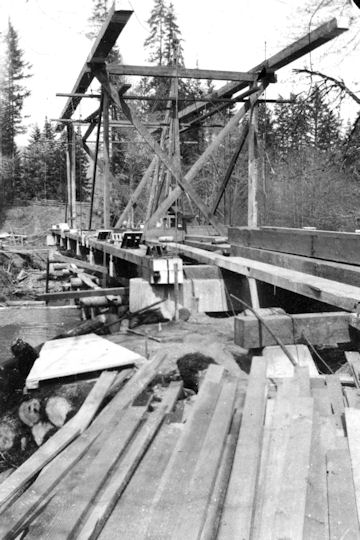
Update on Moscow bridge - May 4, 2010

From: James Crouse
The credit here belongs almost entirely to Larry, for sharing the information with us as it comes to his attention. I thought a few others, including those who write/edit the various CB newsletters/journals, might enjoy Doug's comments also. I recall that he made an interesting presentation at an OHBA meeting on this subject (old CB construction methods).
----- Forwarded Message ----
From: Doug Kramer
To: James Crouse
Sent: Mon, May 3, 2010 7:44:45 PM
Subject: the Moscow CB, now and then
Jim,
Just a quick note to thank you so much for keeping me, and all of us, so well informed as history is remade in Moscow. I really do appreciate it.
Dan's method, with the big cranes, is obviously the best way to go this these days. But the skillful touch of his hands and eyes is still there on each piece of timber, just like that of the Kennedy family over 100 years ago. Most of the timber cutter's "fingerprints" on the wood may now be from the neat-patterned marks of small blades in rows on a steel band or a saw chain, in contrast to the wider and a little more random lines from the handheld chisel or the manpowered adz of yesterday. But for Dan and his crew, it's still a labor of love. Wood makes you think first, maybe even twice as they say, before you act. There's no welding a little back in place to try again. So it's just as special to the Colloms as the Kennedys. Maybe even more so today. There's not nearly so much of it around.
You can bet for sure that, even knowing the Kennedys had to get to the job site with horses, if they had had chainsaws, they would have used them. A lot. And big cranes, too.
As I mention the big cranes, I had to think back over my several years of research lately as I have tried to learn about the methods of construction used in the days of the Kennedys in Rush County, Indiana, of E. S. Sherman, here in Preble County, Ohio, and the many other 19th century bridge builders. There was lots of lightweight and well braced timber false work, all across the river, or maybe a span at a time here, with the unpredictable Flat Rock tamed and squeezed a little bit to hopefully flow on the other side for a while during construction of one span. One or two gin poles to raise up the heavy stuff. Certainly every bit as carefully positioned as Dan did for his cranes. Carefully planned and organized. Each lift, each timber and each notch thought out well in advance, and carefully measured. Twice, I'll bet.
I've tried many times, including asking even there in Moscow, to find old photographs of the construction phases of the early covered bridges. But as one of Dan's old timer Parke County neighbors reminded me, it was just common timber construction back then, like so many barns going up in the neighborhoods around. Nothing newsworthy, really, so rarely were pictures taken. It was a road, for heaven's sake, not the president coming to town.
So thanks again, Jim. By recording the present, you have helped us to revive and appreciate the past, also. I may try to attach one of the old photos I have found, showing the old ways. As I have said when I have presented these to some groups, the methods are a lot different now, but the people not much different at all. The care, the organizing, the teamwork, and even the wood, is pretty much the same. As my grandkids say (I think), how cool is that!
Douglas E. Kramer
President
Kramer & Associates, LLC

[Our thanks to James Crouse for forwarding this story - Ed.]
